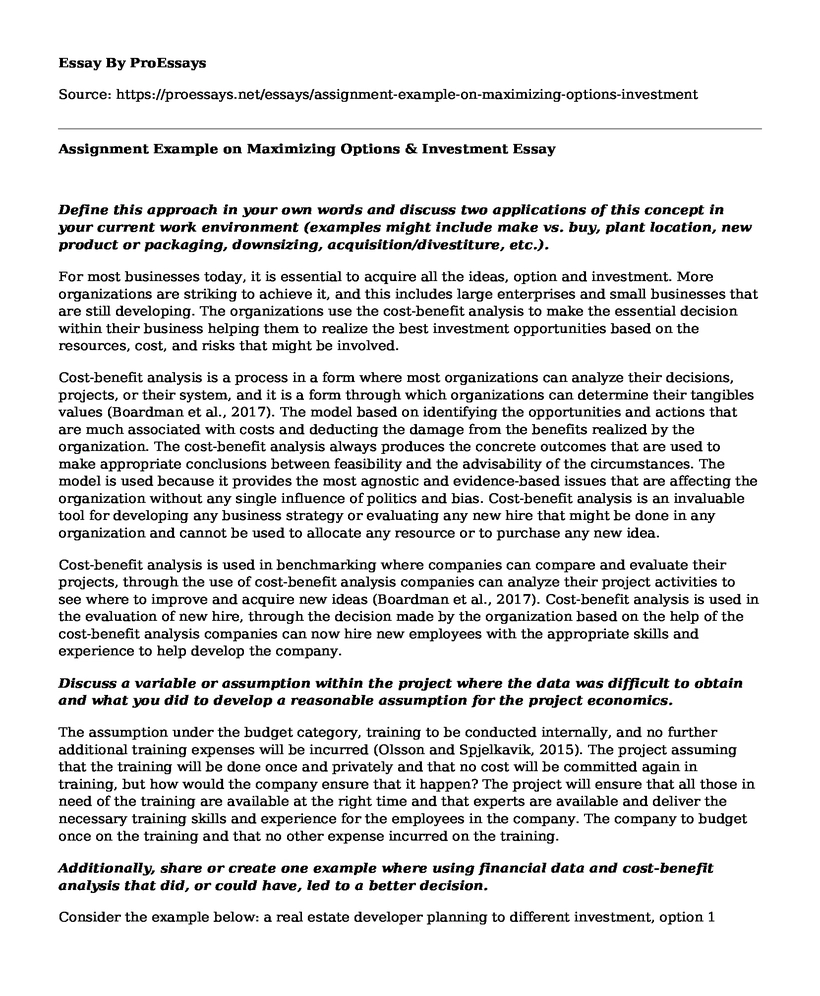Define this approach in your own words and discuss two applications of this concept in your current work environment (examples might include make vs. buy, plant location, new product or packaging, downsizing, acquisition/divestiture, etc.).
For most businesses today, it is essential to acquire all the ideas, option and investment. More organizations are striking to achieve it, and this includes large enterprises and small businesses that are still developing. The organizations use the cost-benefit analysis to make the essential decision within their business helping them to realize the best investment opportunities based on the resources, cost, and risks that might be involved.
Cost-benefit analysis is a process in a form where most organizations can analyze their decisions, projects, or their system, and it is a form through which organizations can determine their tangibles values (Boardman et al., 2017). The model based on identifying the opportunities and actions that are much associated with costs and deducting the damage from the benefits realized by the organization. The cost-benefit analysis always produces the concrete outcomes that are used to make appropriate conclusions between feasibility and the advisability of the circumstances. The model is used because it provides the most agnostic and evidence-based issues that are affecting the organization without any single influence of politics and bias. Cost-benefit analysis is an invaluable tool for developing any business strategy or evaluating any new hire that might be done in any organization and cannot be used to allocate any resource or to purchase any new idea.
Cost-benefit analysis is used in benchmarking where companies can compare and evaluate their projects, through the use of cost-benefit analysis companies can analyze their project activities to see where to improve and acquire new ideas (Boardman et al., 2017). Cost-benefit analysis is used in the evaluation of new hire, through the decision made by the organization based on the help of the cost-benefit analysis companies can now hire new employees with the appropriate skills and experience to help develop the company.
Discuss a variable or assumption within the project where the data was difficult to obtain and what you did to develop a reasonable assumption for the project economics.
The assumption under the budget category, training to be conducted internally, and no further additional training expenses will be incurred (Olsson and Spjelkavik, 2015). The project assuming that the training will be done once and privately and that no cost will be committed again in training, but how would the company ensure that it happen? The project will ensure that all those in need of the training are available at the right time and that experts are available and deliver the necessary training skills and experience for the employees in the company. The company to budget once on the training and that no other expense incurred on the training.
Additionally, share or create one example where using financial data and cost-benefit analysis that did, or could have, led to a better decision.
Consider the example below: a real estate developer planning to different investment, option 1 building 300 houses and renting 50 at $3000 for ten years and sell them after ten years at $60000, the construction cost for one is $80000 that will be sold at $100000 each. The cost sales are $100000, and the salaries for staff sales are $200000 every year, and the project will run for two years and will cost $2000000 each year. Option 2 the construction company would build 200 houses and rent 25 houses for five years at $3500 every year and sell the houses after five years at $70000. The construction cost would be $70000 for option 2 per house, and the rest of the houses would be sold at $110000 each, then the cost sales office would be $2000000 where the sales staff salaries would be $150000 every year, the project would run for 1 tear that will cost $1500000. The total benefit for option one would be $29500000, and option 2 is $21437500. Comparing the two options, option two would be favorable for the investor.
References
Boardman, A. E., Greenberg, D. H., Vining, A. R., & Weimer, D. L. (2017). Cost-benefit analysis: concepts and practice. Cambridge University Press.
Olsson, N. O., & Spjelkavik, I. (2015). Assumption surfacing and monitoring as a tool in project risk management. International Journal of Project Organisation and Management, 6(1-2), 179-196.
Cite this page
Assignment Example on Maximizing Options & Investment. (2023, Mar 09). Retrieved from https://proessays.net/essays/assignment-example-on-maximizing-options-investment
If you are the original author of this essay and no longer wish to have it published on the ProEssays website, please click below to request its removal:
- Essay Samples on Sales Taxes for Online Purchases
- An Evaluation of the End of Behavioral Finance
- Major Causes of Bank's Liquidity Risk in Saudi Arabia Essay Example
- Paper Example on Advertising & Marketing Agency: Concentrating on Increasing Market Share
- Essay Example on Money Fraud: Madoff Investment Scandal
- Essay Example on VW Group's Steady Rise in Revenue: 252 Billion Euros in 2019
- Exploring Abroad on a Budget: Tips for Smart Travelers - Free Essay Example







